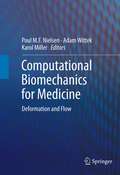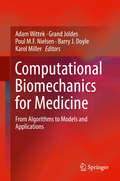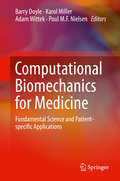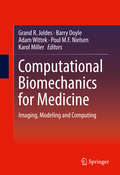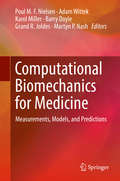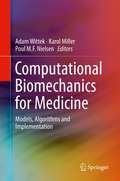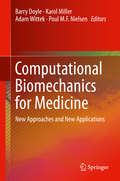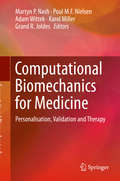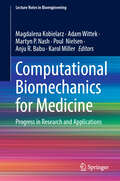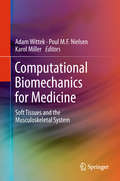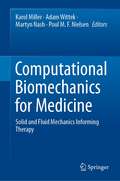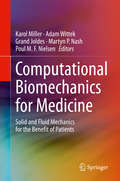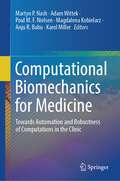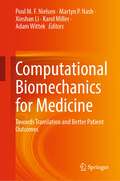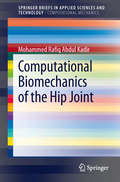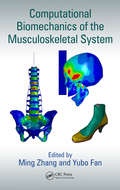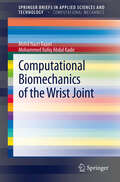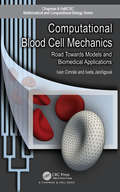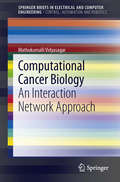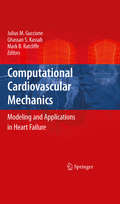- Table View
- List View
Computational Biomechanics for Medicine: Deformation and Flow
by Poul M.F. Nielsen Karol Miller Adam WittekOne of the greatest challenges for mechanical engineers is to extend the success of computational mechanics to fields outside traditional engineering, in particular to biology, biomedical sciences, and medicine. This book is an opportunity for computational biomechanics specialists to present and exchange opinions on the opportunities of applying their techniques to computer-integrated medicine.<P><P> Computational Biomechanics for Medicine: Deformation and Flow collects the papers from the Medical Image Computing and Computer Assisted Intervention conference (MICCAI 2011) dedicated to research in the field of medical image computing and computer assisted medical interventions. The topics covered include: medical image analysis, image-guided surgery, surgical simulation, surgical intervention planning, disease prognosis and diagnostics, injury mechanism analysis, implant and prostheses design, and medical robotics.
Computational Biomechanics for Medicine: From Algorithms to Models and Applications
by Poul M.F. Nielsen Karol Miller Adam Wittek Barry J. Doyle Grand JoldesMathematical modelling and computer simulation have proved tremendously successful in engineering. One of the greatest challenges for mechanists is to extend the success of computational mechanics to fields outside traditional engineering, in particular to biology, biomedical sciences, and medicine. The proposed workshop will provide an opportunity for computational biomechanics specialists to present and exchange opinions on the opportunities of applying their techniques to computer-integrated medicine. For example, continuum mechanics models provide a rational basis for analysing biomedical images by constraining the solution to biologically reasonable motions and processes. Biomechanical modelling can also provide clinically important information about the physical status of the underlying biology, integrating information across molecular, tissue, organ, and organism scales. The main goal of this workshop is to showcase the clinical and scientific utility of computational biomechanics in computer-integrated medicine.
Computational Biomechanics for Medicine: Fundamental Science and Patient-specific Applications
by Karol Miller Adam Wittek Barry Doyle Poul M. F. NielsenOne of the greatest challenges facing the computational engineering community is to extend the success of computational mechanics to fields outside traditional engineering, in particular to biology, the biomedical sciences and medicine. The Computational Biomechanics for Medicine series provides an opportunity for specialists in computational biomechanics to present their latest methodologies and advancements. This 5th edition comprises nine of the latest developments in both fundamental science and patient-specific applications, from researchers in Australia, New Zealand, USA, UK, France, Ireland and China. Some of the interesting topics discussed are: cellular mechanics; tumor growth and modeling; medical image analysis and both patient-specific fluid dynamics and solid mechanics simulations.
Computational Biomechanics for Medicine: Imaging, Modeling and Computing
by Poul M.F. Nielsen Karol Miller Adam Wittek Barry Doyle Grand R. JoldesThe Computational Biomechanics for Medicine titles provide an opportunity for specialists in computational biomechanics to present their latest methodologies and advancements. This volume comprises eighteen of the newest approaches and applications of computational biomechanics, from researchers in Australia, New Zealand, USA, UK, Switzerland, Scotland, France and Russia. Some of the interesting topics discussed are: tailored computational models; traumatic brain injury; soft-tissue mechanics; medical image analysis; and clinically-relevant simulations. <P><P>One of the greatest challenges facing the computational engineering community is to extend the success of computational mechanics to fields outside traditional engineering, in particular to biology, the biomedical sciences, and medicine. We hope the research presented within this book series will contribute to overcoming this grand challenge.
Computational Biomechanics for Medicine: Models, Algorithms And Implementation
by Karol Miller Adam Wittek Barry Doyle Poul M. F. Nielsen Grand R. Joldes Martyn P. NashThis volume comprises the latest developments in both fundamental science and patient-specific applications, discussing topics such as: cellular mechanics, injury biomechanics, biomechanics of the heart and vascular system, algorithms of computational biomechanics for medical image analysis, and both patient-specific fluid dynamics and solid mechanics simulations. With contributions from researchers world-wide, Computational Biomechanics for Medicine: Measurments, Models, and Predictions provides an opportunity for specialists in the field to present their latest methodologies and advancements.
Computational Biomechanics for Medicine: Models, Algorithms And Implementation
by Poul M.F. Nielsen Karol MillerMathematical modelling and computer simulation have proved tremendously successful in engineering. One of the greatest challenges for mechanists is to extend the success of computational mechanics to fields outside traditional engineering, in particular to biology, biomedical sciences, and medicine. The proposed workshop will provide an opportunity for computational biomechanics specialists to present and exchange opinions on the opportunities of applying their techniques to computer-integrated medicine. For example, continuum mechanics models provide a rational basis for analysing biomedical images by constraining the solution to biologically reasonable motions and processes. Biomechanical modelling can also provide clinically important information about the physical status of the underlying biology, integrating information across molecular, tissue, organ, and organism scales. The main goal of this workshop is to showcase the clinical and scientific utility of computational biomechanics in computer-integrated medicine.
Computational Biomechanics for Medicine: Models, Algorithms and Implementation
by Poul M.F. Nielsen Karol Miller Adam WittekOne of the greatest challenges for mechanical engineers is to extend the success of computational mechanics to fields outside traditional engineering, in particular to biology, biomedical sciences, and medicine. This book is an opportunity for computational biomechanics specialists to present and exchange opinions on the opportunities of applying their techniques to computer-integrated medicine. Computational Biomechanics for Medicine: Models, Algorithms and Implementation collects the papers from the Seventh Computational Biomechanics for Medicine Workshop held in Nice in conjunction with the Medical Image Computing and Computer Assisted Intervention conference. The topics covered include: medical image analysis, image-guided surgery, surgical simulation, surgical intervention planning, disease prognosis and diagnostics, injury mechanism analysis, implant and prostheses design, and medical robotics.
Computational Biomechanics for Medicine: New Approaches and New Applications
by Karol Miller Adam Wittek Barry Doyle Poul M. F. NielsenOne of the greatest challenges facing the computational engineering community is to extend the success of computational mechanics to fields outside traditional engineering, in particular to biology, the biomedical sciences and medicine. The Computational Biomechanics for Medicine series provides an opportunity for specialists in computational biomechanics to present their latest methodologies and advancements. This 5th edition comprises nine of the latest developments in both fundamental science and patient-specific applications, from researchers in Australia, New Zealand, USA, UK, France, Ireland and China. Some of the interesting topics discussed are: cellular mechanics; tumor growth and modeling; medical image analysis and both patient-specific fluid dynamics and solid mechanics simulations.
Computational Biomechanics for Medicine: Personalisation, Validation and Therapy
by Karol Miller Adam Wittek Poul M. F. Nielsen Grand R. Joldes Martyn P. NashThis book contains contributions from computational biomechanics specialists who present and exchange opinions on the opportunities for applying their techniques to computer-integrated medicine, including computer-aided surgery and diagnostic systems. Computational Biomechanics for Medicine collects peer-reviewed chapters from the annual Computational Biomechanics for Medicine Workshop, in conjunction with the Medical Image Computing and Computer Assisted Intervention [MICCAI] Society conference. The works are dedicated to research in the field of methods and applications of computational biomechanics to medical image analysis, image-guided surgery, surgical simulation, surgical intervention planning, disease diagnosis and prognosis, analysis of injury mechanisms, implant and prosthesis design, artificial organ design, and medical robotics. These chapters will appeal to a wide range of researchers and students within the fields of engineering and medicine, as well as those working in computational science.
Computational Biomechanics for Medicine: Progress in Research and Applications (Lecture Notes in Bioengineering)
by Karol Miller Adam Wittek Martyn P. Nash Poul Nielsen Magdalena Kobielarz Anju R. BabuThis book presents contributions from the MICCAI 2024 Computational Biomechanics for Medicine Workshop CBM XIX. The peer-reviewed chapters of the book were presented during the 27th International Conference on Medical Image Computing and Computer Assisted Intervention MICCAI held in Marrakesh, Morocco. The content focuses on applications of computational biomechanics to computer-integrated medicine, which includes medical image computing, application of machine learning in image analysis and biomechanics, new approaches to stress computing for biomechanics of soft tissues and evaluation of strain, new assumptions to computing pipelines for disease and injury mechanisms, novel algorithms of computational biomechanics, a unique application of artificial intelligence and neural network in computing and experimental methods for the analysis of disease and injury mechanisms. This book details the state-of-the-art and progress in above mentioned scientific fields for researchers, students, and professionals.
Computational Biomechanics for Medicine: Soft Tissues and the Musculoskeletal System
by Poul M.F. Nielsen Karol Miller Adam WittekOne of the greatest challenges for mechanical engineers is to extend the success of computational mechanics to fields outside traditional engineering, in particular to biology, biomedical sciences, and medicine. The proposed workshop will provide an opportunity for computational biomechanics specialists to present and exchange opinions on the opportunities of applying their techniques to computer-integrated medicine. <P><P> Computational Biomechanics for Medicine: Soft Tissues and the Musculoskeletal System collects the papers from the Medical Image Computing and Computer Assisted Intervention conference (MICCAI 2010) in Beijing, dedicated to research in the field of medical image computing and computer assisted medical interventions. The topics covered include: medical image analysis, image-guided surgery, surgical simulation, surgical intervention planning, disease prognosis and diagnostics, injury mechanism analysis, implant and prostheses design, medical robotics.
Computational Biomechanics for Medicine: Solid and Fluid Mechanics Informing Therapy
by Karol Miller Adam Wittek Poul M. F. Nielsen Martyn NashComputational Biomechanics for Medicine: Solid and fluid mechanics for the benefit of patients contributions and papers from the MICCAI Computational Biomechanics for Medicine Workshop help in conjunction with Medical Image Computing and Computer Assisted Intervention conference (MICCAI 2020) in Lima, Peru. The content is dedicated to research in the field of methods and applications of computational biomechanics to medical image analysis, image-guided surgery, surgical simulation, surgical intervention planning, disease prognosis and diagnostics, analysis of injury mechanisms, implant and prostheses design, as well as artificial organ design and medical robotics. This book appeals to researchers, students and professionals in the field.
Computational Biomechanics for Medicine: Solid and Fluid Mechanics for the Benefit of Patients
by Karol Miller Adam Wittek Poul M. F. Nielsen Grand Joldes Martyn P. NashComputational Biomechanics for Medicine: Solid and fluid mechanics for the benefit of patients contributions and papers from the MICCAI Computational Biomechanics for Medicine Workshop help in conjunction with Medical Image Computing and Computer Assisted Intervention conference (MICCAI 2019) in Shenzhen, China. The content is dedicated to research in the field of methods and applications of computational biomechanics to medical image analysis, image-guided surgery, surgical simulation, surgical intervention planning, disease prognosis and diagnostics, analysis of injury mechanisms, implant and prostheses design, as well as artificial organ design and medical robotics. These proceedings appeal to researchers, students and professionals in the field.
Computational Biomechanics for Medicine: Towards Automation and Robustness of Computations in the Clinic
by Karol Miller Adam Wittek Poul M. F. Nielsen Martyn P. Nash Magdalena Kobielarz Anju R. BabuThis book presents contributions from the MICCAI 2022 Computational Biomechanics for Medicine Workshop. "Computational Biomechanics for Medicine - towards translation and better patient outcomes” comprises papers accepted for the MICCAI Computational Biomechanics for Medicine Workshop held in 2022 in Singapore. The content focuses on applications of computational biomechanics to computer-integrated medicine, which includes MICCAI topics of Medical Image Computing, Computer-Aided Modeling and Evaluation of Surgical Procedures, and Imaging, Analysis Methods for Image Guided Therapies, Computational Physiology, and Medical Robotics. Specific topics covered include medical image analysis, image-guided surgery, surgical simulation, surgical intervention planning, disease prognosis and diagnostics, analysis of injury mechanisms, implant and prostheses design, as well as artificial organ design and medical robotics. This book details state-of-the-art progress in the above fields to researchers, students, and professionals.
Computational Biomechanics for Medicine: Towards Translation and Better Patient Outcomes
by Karol Miller Adam Wittek Poul M. F. Nielsen Martyn P. Nash Xinshan LiThis book presents contributions from the MICCAI 2021 Computational Biomechanics for Medicine Workshop. "Computational Biomechanics for Medicine - towards translation and better patient outcomes” comprises papers accepted for the MICCAI Computational Biomechanics for Medicine Workshop held virtually in conjunction with Medical Image Computing and Computer Assisted Intervention conference 2021, based in Strasbourg. The content focuses on methods and applications of computational biomechanics to medical image analysis, image-guided surgery, surgical simulation, surgical intervention planning, disease prognosis and diagnostics, analysis of injury mechanisms, implant and prostheses design, as well as artificial organ design and medical robotics. This book details state-of-the-art progress in the above fields to researchers, students, and professionals.
Computational Biomechanics of the Hip Joint (SpringerBriefs in Applied Sciences and Technology)
by Mohammed Rafiq Abdul KadirThis book presents analyses of the most commonly reported failure modes of hip stems: loosening and thigh pain; both are attributed to the relative motion and instability at the bone-implant interface due to failure to achieve sufficient primary fixation. The book investigates various factors that could affect primary stability and therefore the long-term outcome of hip arthroplasty. The results complement experimental work carried out in this area as in-vitro experiments have several limitations that could be addressed through computer simulations.
Computational Biomechanics of the Musculoskeletal System
by Ming Zhang Yubo FanComputational biomechanics is an emerging research field that seeks to understand the complex biomechanical behaviors of normal and pathological human joints to come up with new methods of orthopedic treatment and rehabilitation.Computational Biomechanics of the Musculoskeletal System collects the latest research and cutting-edge techniques used in
Computational Biomechanics of the Wrist Joint (SpringerBriefs in Applied Sciences and Technology)
by Mohammed Rafiq Abdul Kadir Mohd Nazri BajuriThis book presents an analysis of the stress distribution and contact stresses in severe rheumatoid wrist after total wrist arthroplasty. It assesses and compares the load transfer throughout the joint and contact pressure at the articulations. The data obtained from this study is of importance as this provide greater evidence to the benefits of total wrist arthroplasty in rheumatoid arthritis patients.
Computational Blood Cell Mechanics: Road Towards Models and Biomedical Applications (Chapman & Hall/CRC Computational Biology Series)
by Ivan Cimrak Iveta JancigovaSimulating blood cells for biomedical applications is a challenging goal. Whether you want to investigate blood flow behavior on the cell scale, or use a blood cell model for fast computational prototyping in microfluidics, Computational Blood Cell Mechanics will help you get started, and show you the path forward. The text presents a step-by-step approach to cell model building that can be adopted when developing and validating models for biomedical applications, such as filtering and sorting cells, or examining flow and deformations of individual cells under various conditions. It starts with basic building-blocks that, together, model the red blood cell membrane according to its physical properties, before moving on to discuss several issues that may pose problems along the way, and finally leads to suggestions on how to set up computational experiments. More details available at www.compbloodcell.eu
Computational Cancer Biology: An Interaction Network Approach (SpringerBriefs in Electrical and Computer Engineering)
by Mathukumalli VidyasagarThis brief introduces people with a basic background in probability theory to various problems in cancer biology that are amenable to analysis using methods of probability theory and statistics. The title mentions "cancer biology" and the specific illustrative applications reference cancer data but the methods themselves are more broadly applicable to all aspects of computational biology. Aside from providing a self-contained introduction to basic biology and to cancer, the brief describes four specific problems in cancer biology that are amenable to the application of probability-based methods. The application of these methods is illustrated by applying each of them to actual data from the biology literature. After reading the brief, engineers and mathematicians should be able to collaborate fruitfully with their biologist colleagues on a wide variety of problems.
Computational Cardiovascular Mechanics: Modeling and Applications in Heart Failure
by Mark B. Ratcliffe Julius M. Guccione Ghassan S. KassabComputational Cardiovascular Mechanics provides a cohesive guide to creating mathematical models for the mechanics of diseased hearts to simulate the effects of current treatments for heart failure. Clearly organized in a two part structure, this volume discusses various areas of computational modeling of cardiovascular mechanics (finite element modeling of ventricular mechanics, fluid dynamics) in addition to a description an analysis of the current applications used (solid FE modeling, CFD). Edited by experts in the field, researchers involved with biomedical and mechanical engineering will find Computational Cardiovascular Mechanics a valuable reference.
Computational Design of Chemicals for the Control of Mosquitoes and Their Diseases (QSAR in Environmental and Health Sciences)
by James DevillersThere is a compelling need for new drugs and efficient treatments against mosquito-borne diseases. Environmentally safe, but effective insecticides that address the problems of resistance are required. Computational Design of Chemicals for the Control of Mosquitoes and Their Diseases explains how the search for new substances effective against mosquitoes and their diseases has benefited from the use of in silico techniques. QSAR modeling is suited to identify the key structural features and/or physicochemical properties explaining an activity and to propose candidate molecules for further evaluation by laboratory tests. Homology modeling is useful to approximate the 3D structure of proteins of interest. Pharmacophore modeling is a powerful means to capture the chemical features responsible for an activity and to identify new potentially active compounds via the virtual screening of databases. Fugacity modeling and a wealth of other modeling paradigms are useful for risk assessment in vector borne disease control.
Computational Diffusion MRI and Brain Connectivity: MICCAI Workshops, Nagoya, Japan, September 22nd, 2013 (Mathematics and Visualization)
by Thomas Schultz Lauren O'Donnell Gemma Nedjati-Gilani Archana Venkataraman Eleftheria PanagiotakiThis volume contains the proceedings from two closely related workshops: Computational Diffusion MRI (CDMRI'13) and Mathematical Methods from Brain Connectivity (MMBC'13), held under the auspices of the 16th International Conference on Medical Image Computing and Computer Assisted Intervention, which took place in Nagoya, Japan, September 2013. Inside, readers will find contributions ranging from mathematical foundations and novel methods for the validation of inferring large-scale connectivity from neuroimaging data to the statistical analysis of the data, accelerated methods for data acquisition, and the most recent developments on mathematical diffusion modeling. This volume offers a valuable starting point for anyone interested in learning computational diffusion MRI and mathematical methods for brain connectivity as well as offers new perspectives and insights on current research challenges for those currently in the field. It will be of interest to researchers and practitioners in computer science, MR physics, and applied mathematics.
Computational Diffusion MRI: MICCAI Workshop, Athens, Greece, October 2016 (Mathematics and Visualization)
by Yogesh Rathi Marco Reisert Andrea Fuster Aurobrata Ghosh Enrico KadenTheseProceedings of the 2015 MICCAI Workshop "Computational Diffusion MRI" offer asnapshot of the current state of the art on a broad range of topics within thehighly active and growing field of diffusion MRI. The topics vary fromfundamental theoretical work on mathematical modeling, to the development andevaluation of robust algorithms, new computational methods applied to diffusionmagnetic resonance imaging data, and applications in neuroscientific studiesand clinical practice. Over thelast decade interest in diffusion MRI has exploded. The technique providesunique insights into the microstructure of living tissue and enables in-vivoconnectivity mapping of the brain. Computational techniques are key to thecontinued success and development of diffusion MRI and to its widespreadtransfer into clinical practice. New processing methods are essential for addressingissues at each stage of the diffusion MRI pipeline: acquisition, reconstruction,modeling and model fitting, image processing, fiber tracking, connectivitymapping, visualization, group studies and inference. Thisvolume, which includes both careful mathematical derivations and a wealth ofrich, full-color visualizations and biologically or clinically relevantresults, offers a valuable starting point for anyone interested in learningabout computational diffusion MRI and mathematical methods for mapping brainconnectivity, as well as new perspectives and insights on current researchchallenges for those currently working in the field. It will be of interest toresearchers and practitioners in the fields of computer science, MR physics,and applied mathematics.
Computational Diffusion MRI: MICCAI Workshop, Munich, Germany, October 9th, 2015 (Mathematics and Visualization)
by Yogesh Rathi Marco Reisert Andrea Fuster Aurobrata Ghosh Enrico KadenTheseProceedings of the 2015 MICCAI Workshop "Computational Diffusion MRI" offer asnapshot of the current state of the art on a broad range of topics within thehighly active and growing field of diffusion MRI. The topics vary fromfundamental theoretical work on mathematical modeling, to the development andevaluation of robust algorithms, new computational methods applied to diffusionmagnetic resonance imaging data, and applications in neuroscientific studiesand clinical practice. Over thelast decade interest in diffusion MRI has exploded. The technique providesunique insights into the microstructure of living tissue and enables in-vivoconnectivity mapping of the brain. Computational techniques are key to thecontinued success and development of diffusion MRI and to its widespreadtransfer into clinical practice. New processing methods are essential for addressingissues at each stage of the diffusion MRI pipeline: acquisition, reconstruction,modeling and model fitting, image processing, fiber tracking, connectivitymapping, visualization, group studies and inference. Thisvolume, which includes both careful mathematical derivations and a wealth ofrich, full-color visualizations and biologically or clinically relevantresults, offers a valuable starting point for anyone interested in learningabout computational diffusion MRI and mathematical methods for mapping brainconnectivity, as well as new perspectives and insights on current researchchallenges for those currently working in the field. It will be of interest toresearchers and practitioners in the fields of computer science, MR physics,and applied mathematics.
